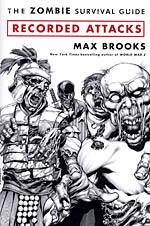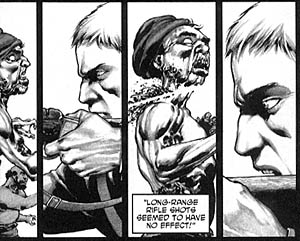 Written by Max Brooks
Written by Max Brooks
Art by Ibraim Roberson
144 pages, black and white
Published by Three Rivers Press
Max Brooks’s World War Z was one of my favorite books of 2006, a fictional series of journalistic articles detailing the start of a zombie outbreak across the globe and how it transformed the world. (If you haven’t read it, I wholeheartedly recommend it; Brooks takes the idea of a global pandemic to a new scale, and even if you "don’t like zombie stories" you will almost certainly find this entrancing.) The Zombie Survival Guide: Recorded Attacks sounded like a perfect companion to the book, a graphic novel of short stories showing earlier zombie uprising over the ages. At the end of the day, though, it didn’t quite pan out as I’d hoped.
 In some ways, I think the largest problem with The Zombie Survival Guide: Recorded Attacks is that the short story format works against it. This was a little surprising to me; World War Z is a book that continually shifts from one story to the next, never staying locked into a situation or location for very long. Here, though, many of the stories lack the same richness that Brooks brought to World War Z. The Zombie Survival Guide: Recorded Attacks dips into a story and pulls out just as quickly, but rarely giving the reader a good feel for more than the absolute basics. World War Z was able to flesh out and humanize most of its characters, but here there isn’t a single person to empathize with or care about beyond the most basic, human level. This could be in part because of the lack of dialogue throughout the book, instead dispassionately told entirely by a narrator. There’s no hook, nothing more than either a "gotcha!" moment, or a historical nod to a past mystery.
In some ways, I think the largest problem with The Zombie Survival Guide: Recorded Attacks is that the short story format works against it. This was a little surprising to me; World War Z is a book that continually shifts from one story to the next, never staying locked into a situation or location for very long. Here, though, many of the stories lack the same richness that Brooks brought to World War Z. The Zombie Survival Guide: Recorded Attacks dips into a story and pulls out just as quickly, but rarely giving the reader a good feel for more than the absolute basics. World War Z was able to flesh out and humanize most of its characters, but here there isn’t a single person to empathize with or care about beyond the most basic, human level. This could be in part because of the lack of dialogue throughout the book, instead dispassionately told entirely by a narrator. There’s no hook, nothing more than either a "gotcha!" moment, or a historical nod to a past mystery.
It’s frustrating, because some of the ideas in The Zombie Survival Guide: Recorded Attacks are fairly clever. Brooks is at his best when telling stories about why things might have happened, like the reasoning behind the removal of brains from Egyptian mummies, or what really occurred on a lost slaver ship in the southern Atlantic Ocean. It’s when the people involved do something clever, like the French Foreign Legion trapped in their fortress for three years before escaping, that Brooks is able to grab the reader’s attention. Too often, though, it’s a very standard and slightly dull story. A lot of the inventiveness from World War Z is surprisingly absent here.
 The best part about The Zombie Survival Guide: Recorded Attacks is Ibraim Roberson’s art. This is of particular note because Roberson’s name is mentioned is only the back cover and in the indicia; it’s not on the spine, the front cover, or the title page. I understand that it’s owned by Brooks and that it’s his baby, but considering that Roberson is the only artist a little more attention could have been provided. I’m familiar with Roberson’s art through some fill-in work on New Mutants, but it’s The Zombie Survival Guide: Recorded Attacks that shows off his real strengths. It’s Roberson who brings a lot of the local color to the book, making the different settings more than just lip service and just as effectively making the zombies incredibly creepy. When it comes to vacant-eyed, decaying bodies, look no further than Roberson. Under his pencil they come across as ruthless and unstoppable killing machines; seeing them sunken on the ocean floor, still staggering forward is a wonderfully effective moment towards selling the ideas that Brooks came up with.
The best part about The Zombie Survival Guide: Recorded Attacks is Ibraim Roberson’s art. This is of particular note because Roberson’s name is mentioned is only the back cover and in the indicia; it’s not on the spine, the front cover, or the title page. I understand that it’s owned by Brooks and that it’s his baby, but considering that Roberson is the only artist a little more attention could have been provided. I’m familiar with Roberson’s art through some fill-in work on New Mutants, but it’s The Zombie Survival Guide: Recorded Attacks that shows off his real strengths. It’s Roberson who brings a lot of the local color to the book, making the different settings more than just lip service and just as effectively making the zombies incredibly creepy. When it comes to vacant-eyed, decaying bodies, look no further than Roberson. Under his pencil they come across as ruthless and unstoppable killing machines; seeing them sunken on the ocean floor, still staggering forward is a wonderfully effective moment towards selling the ideas that Brooks came up with.
The Zombie Survival Guide: Recorded Attacks had huge potential, but compared to World War Z it falls distressingly short. Maybe if you haven’t read Brooks’s novel, this might come across as more inventive and attention-grabbing. It’s a nice footnote to the book, but your expectations need to be kept low if you’re going to get any reasonable amount of enjoyment from the book. It’s a shame, because I think anyone who has read World War Z would be expecting so much more than we actually got.
Purchase Links: Amazon.com | Powell’s Books
